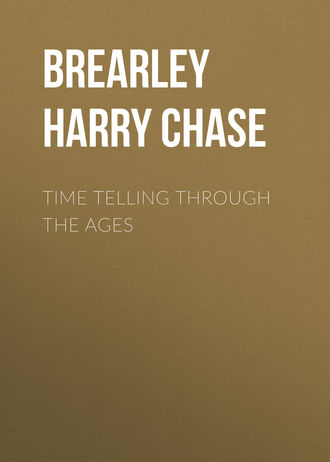 полная версия
полная версияTime Telling through the Ages
Canton Berne – The Swiss district which does the largest export business in silver and base metal watches in Switzerland. The cantonal government has done everything possible to promote the industry, among other things: 1. Established information offices in the principal watch-making centers. 2. Established a permanent exhibition of articles used in the industry. 3. Established schools and associations and protective territories. 4. Prepared statistics and means for negotiating commercial relations.
Cap – The part of the case that covers the movement.
Capped Jewel – A jewel having a protective end-stone.
Carillon – Chimes frequently used in the earlier clocks for striking the hours. Still used in some clocks.
Caron, Peter Augustus – A famous Paris watchmaker, afterward called Beaumarchais, who made the first keyless watch of which we have any account.
Case – The metal box in which the movement of a watch is inclosed.
Case-Springs – The springs which cause the outer bottom of a watch case to fly open when the lock spring is released.
Center of Gyration – That point in which the whole mass of a rotating body might be concentrated without altering its moment of inertia.
Center of Oscillation – That point in a pendulum at which, if the whole mass of the pendulum were collected, the time of oscillation would be the same.
Center Seconds or Sweep Seconds – A long seconds hand moved from the center of a watch dial, as are the minute and hour hands.
Center Staff – The arbor attached to the center wheel which carries the minute hand.
Center Wheel – The wheel in ordinary clocks and watches placed in the center of the frame on whose arbor the minute hand is carried. It is intermediate between the barrel and the third wheel.
Chamfer – To cut away to a bevel the right angle formed by two adjacent faces as of a jewel or stone. It is also occasionally used to signify channeling or grooving.
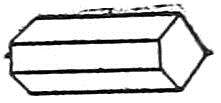
CHAMFER
Chasing – A form of ornament for metals which is made by punching or pressing from behind to present the pattern in relief instead of by cutting away the material.
Chops – In a pendulum clock the blocks, usually of brass, between which the top of the pendulum suspension spring is clipped to prevent its twisting as it swings.
Chronograph – In general, a recording clock or watch. Specifically, a watch with a center-seconds hand which may be stopped, started or returned to zero at will by pressing a button. Used for timing races, or measuring other short spaces of time with great exactness.
Chronometer – Any very accurate time-keeper. Usually understood to mean a time-keeper fitted with a spring detent escapement. They usually have a fusee and a cylindrical balance spring.
Chronometer, Marine – Probably the most exact form of time-keeper, especially for use on shipboard. The driving power is a mainspring acting by a chain on a fusee, and governed by what is known as the Chronometer or Detent Escapement, with, as a rule, the cylindrical balance spring. The movement is mounted on gimbals in an air and water-tight brass case, maintaining the dial constantly in a horizontal position.
Chronoscope – A clock or watch in which the time is shown by figures presented at openings in the dial.
Church, Duane H. – Credited with having contributed more to the automatic features of watch machinery than any other man. He was born in Madison County, N. Y., in 1849. At 16 he was apprenticed to a watchmaker of St. Paul, Minn., and after working at the trade for 17 years, he became in 1882 the master watchmaker for the Waltham Watch Company. Besides his invaluable contributions to automatic machinery, he improved the general design of watch movements and invented a form of pendant setting which enables stem-winding movements to be set in cases not especially adapted to them. He died in 1905.
Circular Error – The difference in time arising from the swinging of a pendulum in a circular arc instead of its true theoretical path which is a cycloidal arc. This caused much trouble in the early clocks. Huyghens attempted to correct it (see Huyghens' Checks) but found that his device caused greater error. With the heavier pendulum and shorter arcs of vibration this error becomes negligible. The suspension of the pendulum by a flat flexible spring instead of a cord, attributed to Dr. Hooke, served to make the path practically cycloidal.
Cleopatra's Needle – An Egyptian obelisk at whose base a dial was marked. Now in London. Another similar obelisk from Egypt is in Central Park, New York City.
Clepsammia – The sand-glass, more familiarly known as the hour-glass. See Hour-glass; Sand-glass.
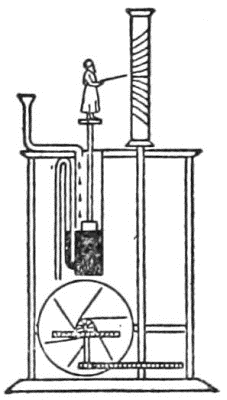
CLEPSYDRA
Clepsydra – A device for the measurement of time by the flow of running water. Its simplest form is a vessel filled with water which trickles or drops slowly from a small aperture into another vessel. One or the other of the vessels is graduated and the height of the water in that one at any given time indicates the hour. Sometimes a figure floating on the water points to the hours. Later, falling, or running, water was made to turn wheels or to move a drum, as in "Vailly's clock." Clepsydras were made and improved up to the 17th century. The earliest known example – one in China – is credited with having existed in 4000 B. C. The name indicates the stealing away of water and is derived from two Greek words meaning "water" and "to steal." A common form of clepsydra in India was a copper bowl with a small hole in the bottom floating on water. When the bowl filled and sank the attendant emptied it, struck the hour upon it and floated it again on the surface of the water. Like the sun-dial, the clepsydra was invented so long ago that there is no authentic record of its origin. Its evident advantages are exactly those which the sun-dial lacked. It is quite independent of day or night or other external conditions; it is conveniently made portable; and by regulating the size of the aperture through which the water flows, it can be made to work slow or fast so as, within considerable limits, to measure accurately and legibly long or short intervals of time.
The disadvantages of the clepsydra were, first, that the hole in the container tended to become worn away so as to let the water out too fast; and second, that the water ran faster from a full vessel than from one nearly empty, because of the greater pressure. This latter was in classic times corrected by a clepsydra consisting of two vessels. The second and larger of these was placed below, the water running into it, out of the first. A float within this larger vessel rose regularly as it filled, and carried a pointer which marked the time. The first vessel from which the water ran into the second, was provided with an overflow, and kept constantly full up to this level; so that the flow of water into the larger vessel remained constant.
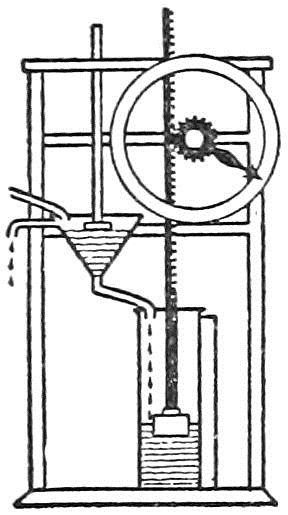
Once well established and understood in principle, the clepsydra became widely known over the ancient world, and underwent a variety of improvements and modifications in form. These latter chiefly dealt with making it more legible. Means were devised, for instance, to make it ring a bell when the water reached a certain height. And thus the alarm principle was very early brought into use. Later on, after the development of mechanical devices like the pulley and the toothed wheel or gear, the pointer was by these means constructed to move faster or slower than the rate at which the water rose, or to revolve upon a circular dial on which the hours were marked. And thus we owe to the clepsydra the origin of the modern clockface as well as of the alarm. Later still, by a more complex ingenuity, devices were arranged to strike the hours or to move mechanical figures, in fact, to perform all the functions of a clockwork which was both driven and regulated by hydraulic power. The single hour hand, however, remained in place of our two or three hands moving at different speeds, as in the modern clock or watch. The clockwork also remained primitive in construction compared with our own. Clepsydrae were always expensive, because accurate mechanical work was never cheapened until modern time. Rather they were made marvels of patient ingenuity and lavish ornament. Cunning oriental craftsmen spent their skill upon elaborate mechanism and costly decorations. The clepsydra thus became first what other time-pieces later became – a triumph of the jeweler's craft – a gift for kings. And the Greeks, who beautified everything that they touched, made it at once more accurate and more artistic.
The clepsydra may thus fairly claim to have been the first mechanical device for measuring time, as contrasted with the sun-dial which was really an astronomical instrument; and thus the direct ancestor of the mechanical clocks of later days. Some authorities, indeed, on the strength of certain very ancient allusions to its use in China and elsewhere, claim for it an antiquity prior to the sun-dial itself. There seems, however, to be no reason for supposing that the discovery of a mechanical law like the regular flow of water antedated so obvious a discovery as the motion of a shadow upon the ground. The explanation is probably that the invention of the clepsydra did precede the scientific perfecting of the sun-dial by the inclinations of the gnomon; which may have taken place about the time of the correction of the Babylonian calendar in 747 B. C. Not long after this date we meet with frequent references to the placing of a clepsydra in the public square of some old city, or to its use in astronomical calculations. To this, of course, its property of running by night was peculiarly adapted.
Although the chief defects of the clepsydra were minimized by the use of the two vessels and by making the aperture through which the water ran of gold or some other substance which would wear away very slowly, yet there remained certain minor imperfections. The water could not be kept entirely from evaporating; it had to be emptied out at intervals and the reservoir refilled; its accuracy was affected by the expansion of the parts under change of temperature, or it might even freeze. These faults were obviated in the sand-glass or hour-glass which for short intervals of time was also more convenient.
The clepsydra remained in use until clocks became superior to it in accuracy. See Clocks, Interesting Old; Charlemagne; Vailly.
Clerkenwell – A district on the north side of the city of London within the metropolitan borough of Finsbury. It is distinguished as one of the great centers of the watchmaking and jewelers' industries in England and long established there. The Northampton Polytechnic Institute, Northampton Square, has a department devoted to instruction in all branches of the trade.
Click – The click, pawl, or dog, is a necessary accessory of a ratchet wheel. It is a finger, one end of which fits into the teeth of the ratchet, while the other is pivoted on its tangent. The ratchet is thus prevented from turning backward.
Clock – Specifically, a time-piece not made to be carried about but to stand upon a shelf or table, hang upon a wall or as built into a tower. Formerly the term signified particularly a time-piece which struck the hours. The word has its origin in the word for bell in Latin, gloccio; Teutonic, glocke; French, cloche; and Saxon, clugga. At one time the term was used to denote timekeepers driven by weights as distinguished from those driven by springs.
Clock-Watch – A watch which strikes the hours in succession, as distinguished from repeaters. Popular in the eighteenth century.
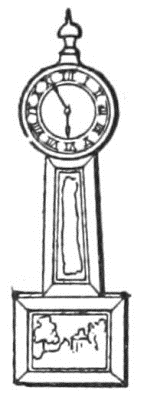
CLOCK-BANJO
Clock, Banjo-A wall clock, so called from its shape, designed by Simon Willard, of Massachusetts and very popular in its time.
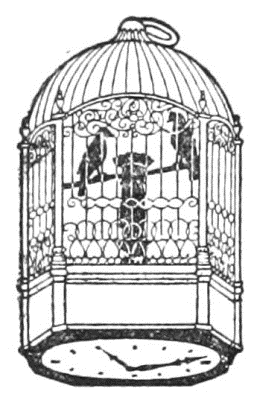
CLOCK, BIRD-CAGE
Clock, Bird-Cage – An old form of English clock whose manufacture has been discontinued – it is the oldest form of English clock still doing service. Its main feature is the endless chain drive. These clocks run thirty hours.
Clock, Bracket – A form of clock very popular in England during the reign of Charles II, made to stand on a bracket or table and intended to be seen from all sides. These clocks had either a handle on top or one on each side. They were very beautifully finished.
Clock, Candle – Wax or tallow candle, usually twelve inches long and marked with circular lines one inch apart. The candle would burn one inch every twenty minutes or three inches an hour. Invention credited to King Alfred the Great.
Clock, Grandfather's or Long-Case – A tall clock with an anchor escapement popular thru-out the later 18th and early 19th centuries in England and America. Its excellent timekeeping qualities are due to the very long and heavy pendulum which allows a small arc of vibration. Not often made at present.

Clock, Hood – A style of clock originating and very popular in Holland during the late 17th century. Made of various woods, carved and ornamented and named from the hood or dome on top.
Clock, Lamp – A long glass tube upright on a metal stand similar in shape to the old Roman lamps. Figures were painted on the tube to indicate the hours – "12" in the middle section, with "11" above and "1" below the "12." The lamp was filled with oil up to the hour at which it was lighted – then as the oil burned away the time was indicated. This form of clock was used at night in Dutch and German rural homes until a comparatively recent date.
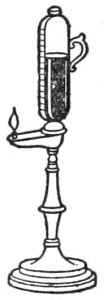
Clock, Lantern – Same as Bird-Cage Clock.
Clock, Largest in World – The Colgate clock in Jersey City is claimed to be twice as large as the next largest clock in the world. Its dial can be read for four miles and weighs six tons. Its minute hand is twenty feet long and the tip of it travels more than half a mile per day.
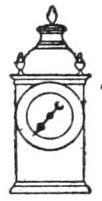
Clock Mysteries – Glass Dial – A perfectly transparent dial behind which no movement was visible. The hands were caused to revolve by watch works and semi-circular weights in the counterpoise of the hands.
Clock, Oldest in America – A clock owned by the Philadelphia Public Library – over two centuries old. It was made in London and is said to have been owned by Oliver Cromwell.
Clock, Sheep's-Head – A clock similar to the bird-cage or lantern clock in which the dial face projects an inch or two beyond the frame.
Clock, Skeleton – A clock whose works are covered with glass as a protection from dust, but are without a case, the works being exposed to view. There are eight skeleton clocks in the Charles Mifflin Hammond collection at the Essex Institute in Salem, Massachusetts.
Clock, Turret – A large clock in which the dials are distinct from the movement. Because of the exposure of the hands to the wind and snow, of the clock to dust and dirt, and of the oil to freezing temperature, turret clocks to keep time must be fitted with some device to obtain a constant force on the pendulum. The first used was the remontoire but since the invention of the gravity escapement for the Westminster clock by Sir Edmund Beckett this has been used instead.

Clock, "Wag on the Wall" – A wall clock typical of the North of Holland in which weights and pendulum hung below the clock case, entirely unenclosed.
Clock and Watch Makers, English, Early – For extensive lists, dates, places, and notes, see: Old Clocks and Watches & Their Makers, by Frederick J. Britten; Worshipful Company of Clockmakers, London, Published by E. J. Francis and Co., London, 1875; Old Clock Book, by Mrs. N. H. Moore.
French, Early – See: Old Clocks and Watches and Their Makers, by F. J. Britten.
Scottish, Early – For extensive list with dates, places and notes, see: Old Scottish Clock Makers, by John Smith.
Clock Makers, American, Early – For lists, dates, places, and notes, see: Old Clock Book, by Mrs. N. H. Moore; American Clockmaking – Its Early History, by Henry Terry.
Clock Mysteries; Tortoise in Water – Nicholas Grollier during the first part of the eighteenth century made many mysterious timekeepers. One was a metal dish filled with water in which floated the figure of a tortoise always keeping his nose to the correct time.
Ball of Venice – This was a sphere – its upper and lower parts gold, and about the middle a silver band bearing the numerals. As the band revolved a Cupid's wing pointed to the hour. Its action was simple. The cord which suspended it was wound about a cylinder. The weight of the ball constituted the driving power. It had a verge escapement. The maker is not known.
Double Globe – Constructed of two clear glass globes, the smaller one for the minutes above the larger hour globe. The mechanism for the latter was in the base, and for the minute globe, in the cap of the hour globe. Made by Henri Cunge.
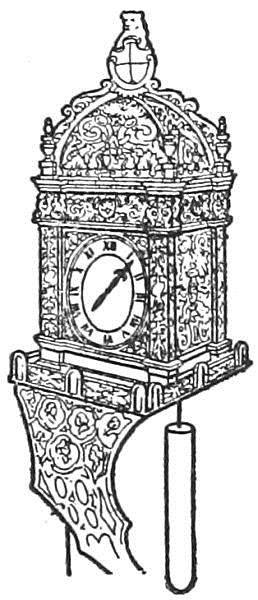
Clocks, Interesting Old: Anne Boleyn's– A clock said to have been presented to Anne Boleyn by Henry VIII on their wedding morning. It is about four inches square and ten inches high, of silver gilt "richly chased, engraved, and ornamented." The weights are of lead covered with copper, gilt and engraved. On one are Henry's and Anne's initials, and true lovers' knots. On the other simply H. A. At the top of each weight is "Dieu et mon droit," at the bottom "The most happye." On the top of the clock is the figure of a lion holding the arms of England, the same being engraved on the sides. The clock is now silent. There is no record as to its maker.
Canterbury– This was the third of the large clocks in England. It was constructed in 1292.
Charlemagne's– In 807 the King of Persia sent Charlemagne a bronze water clock inlaid with gold. The dial consisted of twelve small doors representing the hours. Each door opened at the hour it represented and the correct number of balls fell out upon a brass bell. At twelve o'clock twelve horsemen appeared and shut the doors.
Coblentz– At Coblentz in a tower on the Kaufhaus is a brazen head which gnashes its teeth as the hours strike. For a Coblentzer to say "How is the man in the Kaufhaus" means "How goes it with Coblentz and the good people there?"

de Vick's– In 1364 Henry de Vick set up a clock in the tower of the palace for Charles V. It was regulated by a balance. The teeth of the crown wheel acted upon two small levers called pallets which projected from and formed part of an upright spindle or staff on which was fixed the balance. The clock was regulated by shifting the weights placed at each end of the balance. On the bell of this clock the signal for the massacre of St. Bartholomew's was struck.
Dondi's at Pavia– Built in 1344, by James Dondi, similar to Wallingford's clock.
Exeter– A clock built in Exeter Cathedral sometime in the 14th century. One erected there in 1480 has the sun – a fleur-de-lis which points out the hours as it revolves around a globe representing the earth. A black and white ball represents the moon's phases by turning on its axis.
Frederick II– The Saladin of Egypt presented Frederick II of Germany with a clock in the year 1232. It resembled internally, a celestial globe, in which figures of the sun, moon, and other planets moved impelled by weights and wheels. There were also the twelve signs of the Zodiac which moved with the firmament.
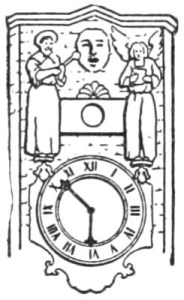
Hans von Jena's– An old clock in Saxony at the top of which is a very ugly head. As the clock strikes a pilgrim offers an apple on a stick to the open mouth and then withdraws it. At the same time an angel opposite the pilgrim raises her eyes from her book. The legend goes that Hans von Jena, for a crime, was condemned to undergo such torture for three centuries.
Jefferson's– An old weight clock in which the weights are carried over a pulley and made to indicate the day of the week by their position. This is in the hallway at Monticello.
Lists and Descriptions of– See Curiosities of Clocks and Watches, E. J. Wood. Old Clocks and Watches and their Makers, F. J. Britten. Old Clock Book, N. H. Moore.
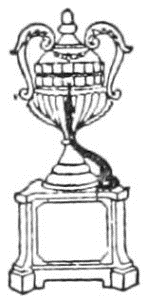
Vase Clocks of Marie Antoinette– The movement was inclosed in a marble pedestal. About the beautifully tinted porcelain urn was a double band, on which were marked the numerals and which revolved every twelve hours. A serpent with head erect pointed to the hour.
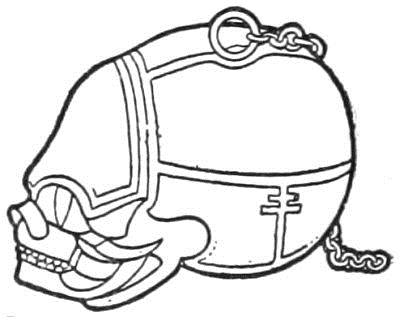
Mary, Queen of Scots– Skull Watch or Clock. A small clock in the form of a skull said to have been given by Mary, Queen of Scots, to Mary Seaton, one of her maids of honor. The skull is of silver gilt and is engraved with figures of Death, Time, Adam and Eve, and the Crucifixion. The lower part of the skull is pierced to emit the sound when it strikes, being cut in the form of emblems of the Crucifixion. The works occupy the brain's position in the skull fitting into a silver bell which fills the entire hollow of the skull. The hours are struck on this bell by a small hammer on a separate train.
Pope Sixtus' – Built by Habrecht of Strasburg in 1589. It greatly resembles the Strasburg clock which Habrecht also built. It was in the possession of the Popes for more than two centuries and later became the property of William I, King of the Netherlands. In 1850 it was exhibited in England after which it became the property of Mr. O. Morgan. It performs all the feats of the Strasburg clock.
Rouen– In the Rue de la Grosse Horloge in Rouen a clock made by Jehan de Fealius in 1389 is built in a tower which surmounts an arched gateway. Its dial is about six feet square. It shows the hours, days of the week, and phases of the moon. It still keeps excellent time and is the chief clock of the city.
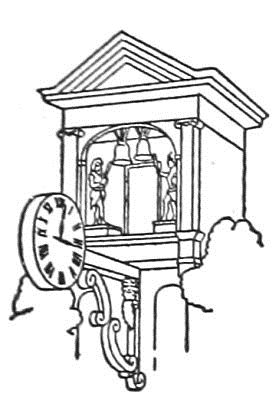
St. Dunstan's– Erected in 1671 above the gateway of the old St. Dunstan's Church. The clock had two dials, back to back upheld by a quaint bracket. In a little open belfry above were the gaily painted figures of Gog and Magog which struck the quarters on bells suspended near them. In 1830 the clock was sold to the Marquis of Hertford who set it up at his home in Regent Park.
St. Paul's– A clock existed prior to 1298 in the tower of St. Paul's Cathedral which struck the hours by means of mechanical figures called Paul's Jacks. Later a fine dial was added.
Strasburg– Rebuilt twice after the first one which was begun about 1352. This first clock consisted of a calendar which showed the principal movable feasts. It showed also the movements of the sun and moon. On the upper part was a statue of the Virgin before which at noon the figures of the three Magi bowed. At the same time a cock automaton opened its beak, flapped its wings and crowed. 2. The second Strasburg clock was erected about 1570. This was a very elaborate mechanism, showing besides the time, a calendar for a century, the movements of the sun and moon, eclipses of the same and other things. The striking was done by an elaborate automatic arrangement. (See Old Clocks and Watches & Their Makers – F. J. Britten.) 3. In 1842 the clock was again thoroughly reconstructed. This, too, is a very elaborate system of motions showing the movements of sun, moon, and planets, also sidereal time, a calendar, etc. The hours and quarters are struck by automatic figures.

